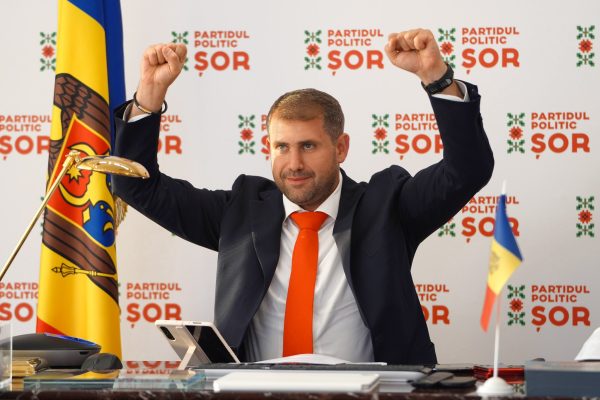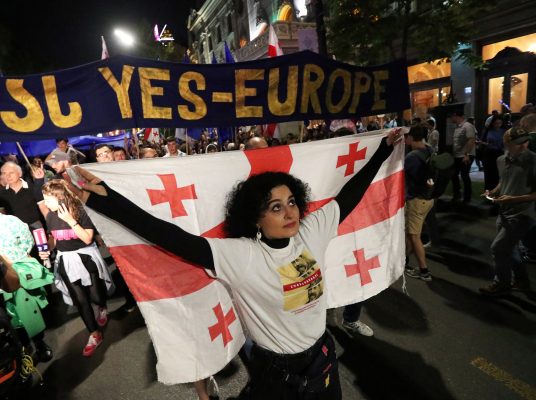A challenger has emerged to Poland’s two-party-dominated system. The new speaker, or Marshal, of Poland’s Sejm, is a seasoned 47-year-old journalist married to a serving Mig-29 fighter pilot, who created a party from scratch using volunteers and public fund-raisers.
An experienced journalist and TV presenter, Szymon Hołownia has already revolutionized public understanding of the legislature and polls say he is the country’s most trusted politician.
The question now is whether he can achieve the much taller order of doing the same to Poland’s pendulum politics. Past third-party campaigns to break the 20-year ding-dong between Donald Tusk and Jaroslaw Kaczynski have failed, indicating the scale of the task.
The personal rivalry between Tusk, the 66-year-old current prime minister, and 74-year-old Kaczynski, has been a recurring and, for some, a frustrating, theme since the 2005 elections. Kaczynski’s Law and Justice (PiS) party and Tusk’s Civic Platform (currently Civic Coalition) comprise two camps that mark the dividing line in Poland’s polarized political landscape.
Hołownia’s Third Way Coalition, including his Poland 2050 party and the Polish People’s Party (PSL) have now joined the government. It became king-maker with a 14% vote in last year’s elections and indeed made Tusk’s majority possible.
The party’s middle ground position inhabits a non-traditional space between the two great behemoths, whose rivalry has if anything deepened since the government’s formation in December.
In recent weeks, Tusk’s government has pursued an ambitious program rooting out eight years of PiS entrenchment in areas like the media and the judiciary. This has generated rage among opposition PiS politicians, who have referred to him inter alia as a dictator, a German agent, and a threat to freedom and democracy. This ad hominem tone is not new, and it serves as a reminder that even popular reforms are only a part of the latest match in an old game.
Hołownia says he seeks to offer a viable alternative to PiS and KO, ending the cycle of personal rivalry, and offering a common depoliticized platform to mend the rifts in Polish society. While surely a noble endeavor, and while Hołownia has met great success to date, this is not the first time an outsider has tried to find a seat at the table.
Two other third-party movements have tried to break into the duopoly, but each failed to gain a lasting position.
Palikot’s Movement (RP), led by businessman turned MP Janusz Palikot, broke onto the scene in the 2011 parliamentary election taking third place with 10% of the vote.
Palikot, who started as a Civic Platform MP, left Tusk’s party to create a new center-left grouping. Despite initial success, RP was short-lived and by the time of the 2015 elections, the group had all but disappeared, failing to gain parliamentary representation.
There was no single reason why the movement collapsed, but there are two factors that stand out. The first is that Palikot himself was not a stable and unifying figure. By the 2015 election, he was no longer even leading the party which had since been rebranded as “Your Movement.”
The other factor is the limited scope of protest parties. While RP had a platform, the party was not able to project itself as an independent alternative. Rather, by the 2015 election, it had been subsumed into the Left political bloc.
The other movement was called Kukiz’15, led by former rockstar Paweł Kukiz. This group was launched after Kukiz gained a shocking 20% in the first round of the 2015 presidential election, with 42% of voters aged between 18 and 29.
This success formed the basis of the new Kukiz’15 party, which went on to win almost 9% in the 2015 parliamentary vote. Unlike Palikot, this movement split to the Right, at first even far-right, with some candidates hailing from the constellation of parties that today comprise the extreme-right Konfederacja.
Despite this initial success, the movement lost steam and by the 2019 elections, it was reduced to only a few seats and was in coalition with PSL. Even more than with RP, Kukiz’15 was a protest party, a big tent movement with a broad and somewhat incoherent program.
Paweł Kukiz remained a charismatic leader, but by 2021 the now-minor party was all but forced to join with PiS in the United Right Coalition. For a party that started as a protest, it ended as an appendage of the establishment.
There are a number of lessons to be drawn from the previous attempts to forge a third way in Poland’s political system.
The first is the distinction between a protest group and an alternative. The two are not the same. Dependence on general discontent is a political death knell — to survive, parties must build a substantive and stand-alone platform, The second is the need for stable leadership, built by politicians who endure as unifying representatives. The third is retaining independence, not just from the behemoths of KO and PiS, but also from the fringes of the political spectrum on the left and right.
So far, Hołownia has managed this relatively well. As a movement, Poland 2050 and the Third Way Coalition have managed to hold the center ground, and while they are in government with Tusk’s KO, they have not been subsumed.
Hołownia, for his part, has emerged as both an effective and charismatic leader. As Marshal of the Sejm, he has led a PR coup with the Sejm YouTube Channel which has grown to over 700,000 subscribers.
Hołownia, with his TV experience, has capitalized on the platform. In mid-January, two surveys rated him the most trusted politician in Poland scoring between 46% and 54%. Likewise, in the polls, the Third Way is still maintaining its position, and even making modest gains.
Four years on from its founding in 2020, the party is prospering more than earlier outsider movements.
Yet, while Hołownia may already represent a shift in Poland’s political make-up it is still too early to judge whether he will earn a lasting place at the table. What is sure is that Hołownia and his party will be important to watch, showing either that he is the first of a new brand of politician, or as further proof of an enduring political establishment.
Nathan Alan-Lee is a doctoral researcher at the School of Slavonic and East European Studies, University College London, and is a commentator on Polish and regional affairs.
Europe’s Edge is CEPA’s online journal covering critical topics on the foreign policy docket across Europe and North America. All opinions are those of the author and do not necessarily represent the position or views of the institutions they represent or the Center for European Policy Analysis.





